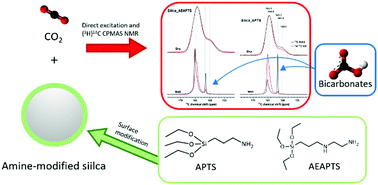Chemisorption of CO2 on diaminated silica as bicarbonates and different types of carbamate ammonium ion pairs
Abstract
The chemisorption of CO2 on aminated silica has a rich chemistry, and its details are important to research in relation to CO2 capture and catalytic chemistry. In this study, such chemisorption was investigated on aminated and diaminated silica with 1H and 13C solid state nuclear magnetic resonance (NMR) spectroscopy under dry and wet conditions. Fast magic-angle spinning (MAS) allowed us to obtain high resolution spectra. Porous silica was modified into a monoaminated version using (3-aminopropyl)triethoxysilane (APTS) and a diaminated one by using 3-(2-aminoethylamino)propyltriethoxysilane (AEAPTS). From the corresponding NMR spectra we could conclude that, under dry conditions, CO2 chemisorbed as carbamic acid and carbamate ammonium ion pairs and gave similar spectra for both directly-excited 13C and under cross-polarization (CP) {1H}13C MAS NMR. Under wet conditions, direct excitation and {1H}13C CPMAS NMR showed that carbamate ammonium ion pairs formed along with bicarbonates (HCO3−). For the wet conditions, the 13C and 1H NMR spectra were especially well resolved, and we could detect two different types of carbamate ammonium ion pairs forming on the diaminated silica. We conclude that carbamate ammonium ion pairs and HCO3− moieties can be detected by {1H}13C MAS NMR, at least qualitatively, in addition to the more time consuming direct excitation.



 Please wait while we load your content...
Please wait while we load your content...